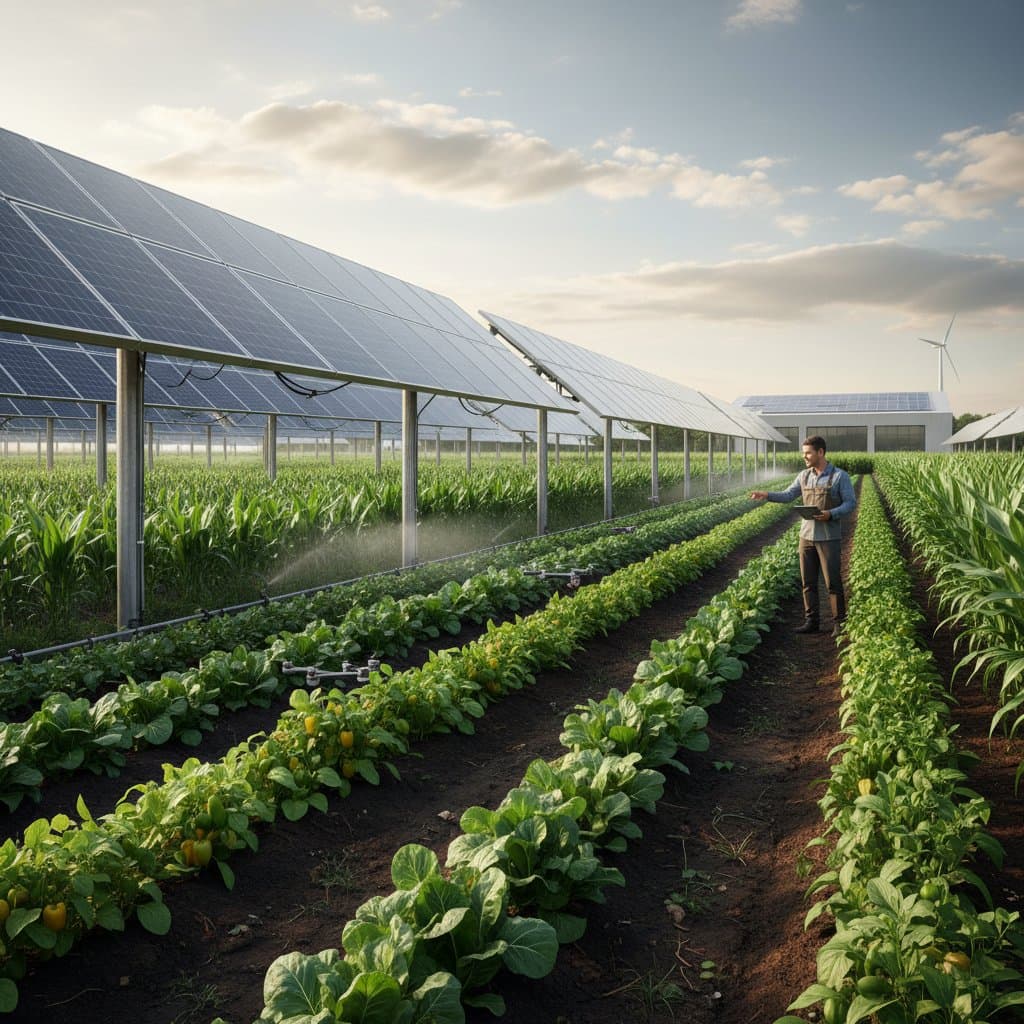Why Farming Under Solar Panels Increases Yields in 2025
Solar energy integration with agriculture presents opportunities that address common concerns among farmers. Many question whether panels obstruct sunlight and negatively affect plant growth. In practice, thoughtfully designed installations enhance crop performance, conserve water, and provide reliable income streams. This method, termed agrivoltaics or dual-use solar, reimagines farmland as a multifunctional space for both electricity production and food cultivation.
Understanding Agrivoltaics
Agrivoltaics involves elevating solar panels to allow sufficient space for crops or grazing animals below. Panels receive direct sunlight while permitting diffused light to penetrate to the ground level. Engineers customize row spacing, panel tilt angles, and heights based on specific crop requirements, soil conditions, and regional solar patterns.
As sunlight interacts with the panels, a portion generates electricity, and the remainder filters downward as shaded, scattered illumination. This environment moderates temperatures and minimizes water loss from plants. Integrated sensors monitor variables such as soil humidity, ambient heat, and light diffusion, enabling real-time adjustments to optimize both energy output and agricultural productivity.
Factors Driving Higher Crop Yields
The partial shading from elevated panels benefits shade-tolerant plants by mitigating heat stress. Crops like lettuce, spinach, beans, peppers, and various berries experience reduced wilting and prolonged viability during peak summer conditions. This microclimate fosters extended growing periods and improved plant resilience.
Field trials demonstrate yield gains ranging from 5 to 15 percent across different crops and regions. For instance, peppers cultivated under panels on a half-acre plot often match or exceed outputs from a full acre in unshaded fields, thanks to sustained hydration. Healthier plants develop robust root networks, which support greater nutrient uptake.
Shading also enhances soil moisture retention, potentially lowering irrigation demands by 20 to 30 percent. Panels serve as natural barriers against wind, which helps preserve topsoil and promotes beneficial microbial ecosystems in the soil. These combined effects lead to more vigorous growth and higher overall harvests.
Balancing Energy Production and Farm Income
Dual-use configurations typically feature fewer panels per acre than dedicated solar farms, yet they deliver substantial energy yields. A 200-kilowatt ground-mounted array, for example, might produce approximately 260,000 kilowatt-hours annually. Valued at 15 cents per kilowatt-hour, this translates to about 39,000 dollars in yearly revenue.
Farms can consume a portion of the generated power for operations like irrigation pumps, cooling systems, and indoor lighting, while exporting the surplus via net metering arrangements. This dual revenue from energy sales and crop production often surpasses income from agriculture alone. Diversification strengthens financial stability against market fluctuations.
Eligible projects access federal investment tax credits that offset significant installation expenses. Additional state grants, utility rebates, and agricultural subsidies further reduce upfront costs. With these supports, systems achieve payback within 6 to 10 years, factoring in local labor rates and material expenses.
Key Design Considerations for Success
Effective agrivoltaic systems prioritize site-specific adaptations. Panel heights of 8 to 12 feet ensure clearance for machinery and human access. Wider row spacing than in conventional solar installations promotes uniform light distribution to crops.
Some designs incorporate tracking mechanisms that orient panels throughout the day, fine-tuning shade patterns to suit plant needs. Beneath the arrays, farmers select ground covers such as low-stature crops or native pollinator habitats to enhance biodiversity and soil quality.
Prior to implementation, professionals conduct assessments of terrain slope, geographic latitude, soil composition, and existing irrigation infrastructure. These evaluations include simulations of light penetration and projected crop performance to inform precise layouts.
Ongoing Maintenance and Sustainability
Agrivoltaic sites demand routine care for both solar components and underlying agriculture. Cleaning panels two to four times annually prevents dust accumulation and sustains efficiency. Crops require standard practices like pruning, fertilization, and integrated pest management, facilitated by the elevated structure.
Digital monitoring platforms integrate data from energy meters and environmental sensors. Operators analyze correlations between shade levels, temperature variations, and growth metrics to refine watering schedules and planting decisions. This iterative approach maximizes long-term yields.
Well-maintained systems endure for 25 to 30 years, after which recyclable panels leave the land ready for continued farming. The enduring benefits include reduced operational risks and alignment with climate adaptation strategies.
Realizing Long-Term Farm Resilience
Adopting agrivoltaics equips farms to thrive amid changing environmental and economic pressures. Enhanced yields, water efficiency, and diversified income create pathways to sustainability. Farmers who integrate these systems position themselves for greater profitability and ecological stewardship in the years ahead.
FAQ
Which crops thrive under solar panels?
Leafy greens such as lettuce and spinach, root vegetables like carrots, and fruits including berries adapt well to partial shade environments.
Does shading impact solar energy generation?
Shading does not compromise panel efficiency, as designs ensure full sun exposure atop while providing diffused light below.
Is grazing livestock compatible with solar installations?
Livestock integration works effectively; sheep, for instance, manage undergrowth without risking equipment damage.
What minimum land size supports an agrivoltaic setup?
A single acre accommodates roughly 250 kilowatts of panels alongside ample space for cultivation or pasture.
Are installation costs higher for dual-use systems?
Initial expenses rise modestly due to elevated supports and tailored configurations, though incentives substantially mitigate these increases.
Can established solar arrays be modified for agriculture?
Retrofits prove feasible when heights and spacings permit access; elevating structures on reinforced mounts often resolves constraints.
